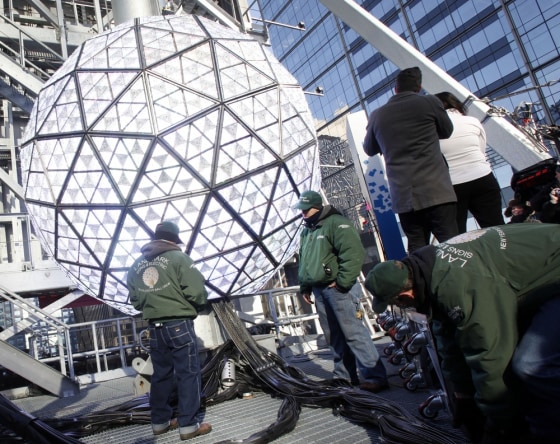As you head out to ring in the New Year, take a cue from that iconic ball in Times Square. It sips its juice rather than guzzling it, and glows brighter than ever.
The ball, which drops 77 feet down a pole as New Yorkers count down the final minute to 2011, is lit by 32,256 Philips LEDs (light-emitting diodes), with each 48-diode module using just 22 watts of electricity. As a result, the lights consume about the same amount of energy per hour as it takes to operate two traditional home ovens.
But that energy frugality doesn't mean New York is skimping on the bling: Each light can be digitally controlled to create a palette of more than 16 million colors and billions of possible lighting effects.
The ball is a geodesic sphere, 12 feet in diameter and weighing 11,875 pounds. It's covered with 2,688 Waterford crystal triangles that are cut in different patterns. This year, 288 of the triangles are emblazoned with a new heart-themed glass pattern called "Let There Be Love." (The other 2,400 triangles feature patterns from past years.)
Times Square's first New Year's ball drop took place in 1907, with 100 light bulbs mounted on an iron-and-wood frame. Philips has been lighting the ball for 11 years, beginning with an array of specially designed halogen bulbs for the 1999-2000 celebration. The company replaced the halogen with LED technology for 2008, and used even more efficient LEDs starting with the New Year's celebration for 2009.
"Today's ball is lit all year round and uses just 12 percent of the energy that would have been required to light it with the original technology," Philips said in a press release.
The numerals that light up to display "2011" are also all-LED, and consume about as much power as a 40-gallon home water heater, Philips said. Over the past month, visitors to New York have been stopping by Duracell's Smart Power Lab to pedal a stationary bike and generate electricity for the "2011" numerals. The "Final Pedal" celebrity event took place just today. On New Year's Eve, all that stored-up pedal power will help ring in the new year.
How would you make things even more energy-efficient for 2012? Do you have some "green" resolutions for the new year? Feel free to discuss the alternative energy outlook for the next 12 months in your comments below.
Update for 5:45 p.m. ET by Alan Boyle: It almost takes an electrician to figure out the wattage of the Times Square ball — and compare it to household electrical use. When Philips says it takes 22 watts to produce the light level that previously required 180 watts, it's talking about the 48-LED modules used in the ball. That's 12 LEDs each for red, blue, green and white. The ball has 672 of those 22-watt modules, which means the entire ball would require 14,784 watts of electricity. The comparison to traditional home ovens would be valid if you were running two 7.5-kilowatt cooking appliances continuously at full blast — which would make the kitchen blazing-hot.
John Roach is a contributing writer for msnbc.com. Connect with the Cosmic Log community by hitting the "like" button on the Cosmic Log Facebook page or following msnbc.com's science editor, Alan Boyle, on Twitter (@b0yle).
